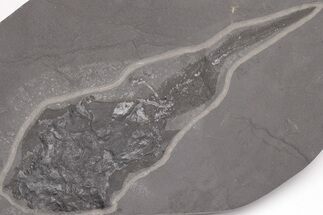This Specimen has been sold.
Museum Quality Armored Fish Fossil - Scotland
This is a one-of-a-kind 370 million year old fossil worthy of the finest museum collections. It's a complete armored fish (Coccosteus cuspidatus) from the Orcadian Slate quarries near Caithness, Scotland. It's 13 inches long on a 28x18 slab of matrix and is 100% natural with no restoration or repair. The preservation is impeccable and I can say it's without a doubt one of the best specimens of these rare armored fish EVER found.
This specimen was acquired by a high-end collector back in the late 80's who only sought out the finest specimens for his collection. He is now narrowing the focus of his collection away from fish. Watch for more rare, one-of-a-kind fossil offerings from this collection in the next several days.
Please contact us if you are interested to arrange payment.
Coccosteus was an arthrodire, belonging to an extinct order of armoured, jawed fishes (placoderms) found in Devonian freshwater and marine deposits. (The Devonian period lasted from 416 million to 359 million years ago.) The earliest arthrodires, such as Arctolepis, were fully-armoured fishes with flattened bodies. They had hollow, backward-curved shoulder spines and may have used the long spines to anchor themselves or to move about on the bottom.
Later arthrodires, such as this Coccosteus, were less heavily armoured tand the bony head and body shields were connected by a joint on each side allowing free head movement. They were predators and had bony jaws that allowed for incredible crushing bite power Two toothplates were present on each side of an arthrodire’s upper jaw, and one toothplate was present on each side of its lower jaw. The back of the body and the tail were apparently naked, and its headshield was reduced, an evolutionary requiredment of increasingly predatory habits. The shoulder spine was shortened..
The famous “terror of the Devonian seas “Dunkleosteus) was very similar in appearance to Coccosteus but grew in excess of 30 feet) Coccosteans were typically under 2 feet in length.
This specimen was acquired by a high-end collector back in the late 80's who only sought out the finest specimens for his collection. He is now narrowing the focus of his collection away from fish. Watch for more rare, one-of-a-kind fossil offerings from this collection in the next several days.
Please contact us if you are interested to arrange payment.
Coccosteus was an arthrodire, belonging to an extinct order of armoured, jawed fishes (placoderms) found in Devonian freshwater and marine deposits. (The Devonian period lasted from 416 million to 359 million years ago.) The earliest arthrodires, such as Arctolepis, were fully-armoured fishes with flattened bodies. They had hollow, backward-curved shoulder spines and may have used the long spines to anchor themselves or to move about on the bottom.
Later arthrodires, such as this Coccosteus, were less heavily armoured tand the bony head and body shields were connected by a joint on each side allowing free head movement. They were predators and had bony jaws that allowed for incredible crushing bite power Two toothplates were present on each side of an arthrodire’s upper jaw, and one toothplate was present on each side of its lower jaw. The back of the body and the tail were apparently naked, and its headshield was reduced, an evolutionary requiredment of increasingly predatory habits. The shoulder spine was shortened..
The famous “terror of the Devonian seas “Dunkleosteus) was very similar in appearance to Coccosteus but grew in excess of 30 feet) Coccosteans were typically under 2 feet in length.
SPECIES
Coccosteus cuspidatus
LOCATION
Caithness, Scotland
FORMATION
Orcadian Slate
SIZE
13’ in length on a 28”x18” matrix
CATEGORY
SUB CATEGORY
ITEM
#5968
We guarantee the authenticity of all of our specimens.
 Reviews
Reviews














